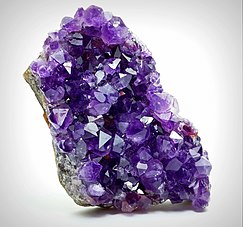| Violet | |
|---|---|
| Spectral coordinates | |
| Wavelength | 380–435 nm |
| Frequency | 790–690 THz |
| Hex triplet | #8000FF |
| sRGBB (r, g, b) | (128, 0, 255) |
| HSV (h, s, v) | (270°, 100%, 100%) |
| CIELChuv (L, C, h) | (41, 134, 275°) |
| Source | W3C[1] |
| B: Normalized to [0–255] (byte) H: Normalized to [0–100] (hundred) | |
Violet is the color of light at the short wavelength end of the visible spectrum. It is one of the seven colors that Isaac Newton labeled when dividing the spectrum of visible light in 1672. Violet light has a wavelength between approximately 380 and 435 nanometers.[2] The color's name is derived from the Viola genus of flowers.[3][4]
In the RGB color model used in computer and television screens, violet is produced by mixing red and blue light, with more blue than red. In the RYB color model historically used by painters, violet is created with a combination of red and blue pigments and is located between blue and purple on the color wheel. In the CMYK color model used in printing, violet is created with a combination of magenta and cyan pigments, with more magenta than cyan. On the RGB/CMY(K) color wheel, violet is located between blue and magenta.
Violet is closely associated with purple. In optics, violet is a spectral color (referring to the color of different single wavelengths of light), whereas purple is the color of various combinations of red and blue (or violet) light,[5][6] some of which humans perceive as similar to violet. In common usage, both terms are used to refer to a variety of colors between blue and red in hue.[7][8][9]
Violet has a long history of association with royalty, originally because Tyrian purple dye was extremely expensive in antiquity.[10] The emperors of Rome wore purple togas, as did the Byzantine emperors. During the Middle Ages, violet was worn by bishops and university professors and was often used in art as the color of the robes of the Virgin Mary.[11] In Chinese painting, the color violet represents the "unity transcending the duality of Yin and yang" and "the ultimate harmony of the universe".[12] In New Age thinking, purple and/or violet is associated with the crown chakra.[13] One European study suggests that violet is the color people most often associate with extravagance, individualism, vanity and ambiguity.[14]
- ^ Çelik, Tantek; Lilley, Chris, eds. (18 January 2022). "CSS Color Module Level 3". W3C. w3.org. Retrieved 10 September 2022.
- ^ Georgia State University Department of Physics and Astronomy. "Spectral Colors". HyperPhysics site. Retrieved 20 October 2017.
- ^ "violet, n.1". OED Online. Oxford University Press. Retrieved 6 April 2020.
- ^ "Violet". Webster's Third New International Dictionary, Unabridged. Retrieved 6 April 2020.
- ^ P. U.P. A Gilbert and Willy Haeberli (2008). Physics in the Arts. Academic Press. p. 112. ISBN 978-0-12-374150-9.
- ^ Louis Bevier Spinney (1911). A Text-book of Physics. Macmillan Co. p. 573.
- ^ Tager, A.; Kirchner, E.; Fedorovskaya, E. (2021). "Computational evidence of first extensive usage of violet in the 1860s". Color Research & Application. 46 (5): 961–977. doi:10.1002/col.22638. S2CID 233671776.
- ^ Fehrman, K.R.; Fehrman, C. (2004). Color - the secret influence. Upper Saddle River: Pearson Education.
- ^ Matschi, M. (2005). "Color terms in English: Onomasiological and Semasiological aspects" (PDF). Onomasiology Online. 5: 56–139. Archived (PDF) from the original on 9 October 2022.
- ^ Dunn, Casey (9 October 2013). "The Color of Royalty, Bestowed by Science and Snails". The New York Times. ISSN 0362-4331. Retrieved 4 April 2020.
- ^ Elliot, Charlene (Winter 2008). "Purple pasts: Color codification in the ancient world". Law and Social Inquiry. 33 (1): 173–194. doi:10.1111/j.1747-4469.2008.00097.x. S2CID 145236881. Retrieved 26 June 2021.
- ^ Varichon, Anne Colors:What They Mean and How to Make Them New York:2006 Abrams Page 138
- ^ "Meanings of Purple/Violet - Color Wheel Artists". www.color-wheel-artist.com. Archived from the original on 8 May 2017. Retrieved 15 January 2022.
- ^ Eva Heller, Psychologie de la couleur: effets et symboliques. p. 4. "La plus individualist et extravagant des coulours." (associated by 26 percent of respondents to survey with "extravagance", by 22 percent with "individualism", 24 percent with "vanity", 21 percent with "ambiguity").



